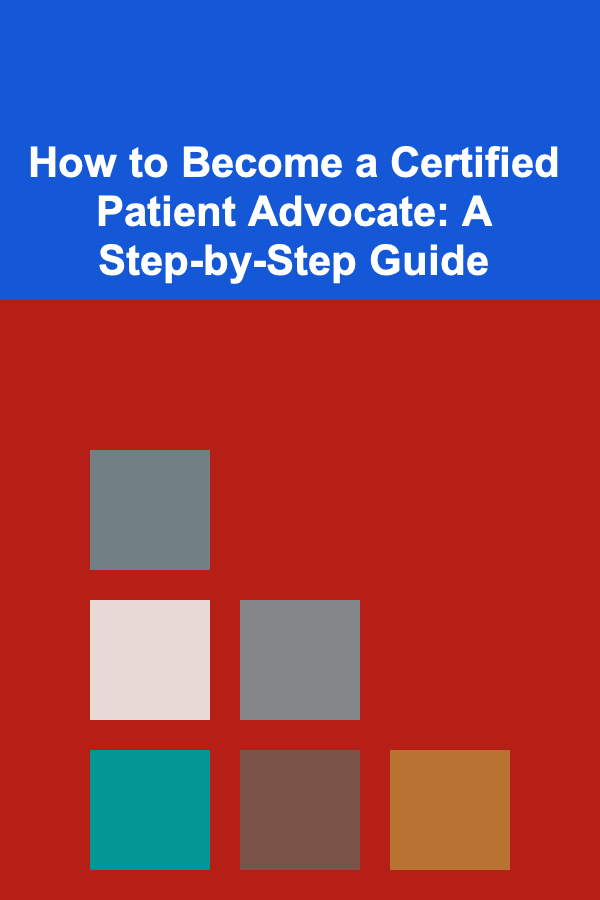
How to Become a Certified Patient Advocate: A Step-by-Step Guide
ebook include PDF & Audio bundle (Micro Guide)
$12.99$6.99
Limited Time Offer! Order within the next:

Patient advocacy is an essential aspect of healthcare that involves supporting patients as they navigate the complex and often overwhelming healthcare system. Whether it's helping a patient understand their diagnosis, assisting with insurance issues, or ensuring they receive the best possible care, patient advocates play a vital role in promoting the well-being of patients. If you're passionate about helping others and want to make a meaningful difference in the healthcare system, becoming a certified patient advocate could be a fulfilling career path.
This comprehensive guide will walk you through the steps involved in becoming a certified patient advocate, including the education, skills, certification process, and career outlook.
What is a Patient Advocate?
A patient advocate is a professional who works to support and represent patients in healthcare settings. Patient advocates act as a liaison between patients and healthcare providers, ensuring that patients' rights are upheld and that their needs are met in the healthcare system. This can involve a variety of roles, such as:
- Helping patients understand their medical options and making informed decisions
- Navigating healthcare systems, including insurance companies and hospital policies
- Assisting with paperwork, forms, and medical bills
- Coordinating care between multiple healthcare providers
- Ensuring patients' rights and preferences are respected
Certified patient advocates (CPAs) possess specialized knowledge and training that qualify them to work in a variety of healthcare settings, from hospitals to private practice, insurance companies, and even nonprofit organizations.
Why Become a Certified Patient Advocate?
There are several reasons why someone might choose to become a certified patient advocate:
- Making a Difference: Helping individuals in difficult medical situations can be incredibly rewarding. You'll be able to advocate for vulnerable patients and ensure they receive the care they deserve.
- In-Demand Profession: With healthcare systems becoming more complex, the demand for patient advocates is on the rise. Many hospitals, insurance companies, and even private practice organizations are hiring certified patient advocates to assist patients.
- Diverse Career Opportunities: Certified patient advocates can work in a variety of settings, from hospitals and healthcare organizations to private practice or freelance advocacy. Some even choose to focus on a specific medical field, such as oncology or pediatrics.
- Job Flexibility: Patient advocacy can be a flexible career path. Many certified advocates have the option to work remotely, set their own hours, or operate as independent consultants.
- Personal Fulfillment: If you are passionate about healthcare and helping people navigate difficult situations, patient advocacy can provide immense personal fulfillment. This career offers the opportunity to make a positive impact in people's lives.
Step 1: Understand the Role of a Patient Advocate
Before pursuing certification, it's important to understand what being a patient advocate entails. The role can vary based on the setting, but generally, it includes the following duties:
- Patient Education: Educating patients about their diagnosis, treatment options, and their rights in the healthcare system.
- Care Coordination: Ensuring all of a patient's healthcare providers communicate effectively and that the patient receives coordinated care.
- Communication: Helping patients communicate effectively with doctors, nurses, and other healthcare professionals.
- Navigating Systems: Assisting with insurance claims, medical billing, and understanding healthcare policies and benefits.
- Support and Emotional Guidance: Offering emotional support to patients and their families during difficult times, helping them manage stress, fear, and anxiety associated with healthcare decisions.
In addition to these responsibilities, patient advocates may also handle administrative duties such as managing medical records or ensuring compliance with healthcare regulations.
Step 2: Gain Relevant Education and Experience
While formal education is not always required to become a patient advocate, gaining relevant education and experience can help you develop the skills needed for the job. Many advocates have backgrounds in healthcare, social work, or law, but it's not necessary to have a degree in one of these fields.
Here are some steps to gain the necessary knowledge and experience:
1. Education
While you don't necessarily need a degree to become a patient advocate, pursuing a degree in a related field can be beneficial. Here are some relevant degrees:
- Healthcare Administration: A degree in healthcare administration will provide you with knowledge about healthcare systems, insurance policies, medical terminology, and healthcare laws, all of which are crucial for patient advocacy.
- Nursing: If you have a nursing background, your experience working directly with patients can be invaluable in a patient advocacy role.
- Social Work: A degree in social work teaches you how to work with individuals in difficult circumstances, a skill that is highly transferable to patient advocacy.
- Public Health: A public health degree can give you insight into healthcare policies and the systemic challenges that patients face.
Many educational programs now offer patient advocacy courses, including online programs, so if you don't already have a degree, consider pursuing these to build a foundation.
2. Experience in Healthcare or Related Fields
Experience in healthcare or a related field can help you understand the complexities of the healthcare system. This experience may come from roles such as:
- Healthcare Worker: Roles like nursing, medical assisting, or even working as a medical secretary or in healthcare administration provide valuable experience.
- Social Work: Working in social services, particularly in healthcare settings, can provide a strong foundation for understanding patient needs and care coordination.
- Volunteering: Volunteering in hospitals or clinics gives you exposure to patient advocacy work and can help you build the necessary skills and connections.
3. Skill Development
In addition to formal education and work experience, certain skills are essential for a patient advocate to be effective:
- Communication: Strong verbal and written communication skills are critical. You'll need to explain complex medical terminology and treatment options to patients in a way that they can understand.
- Critical Thinking and Problem-Solving: Patient advocates must analyze complex situations, prioritize tasks, and offer solutions that benefit the patient.
- Empathy and Compassion: A genuine desire to help people is essential, as patient advocates often work with patients in distressing situations.
- Organization: Managing paperwork, medical records, insurance claims, and communication with healthcare professionals requires excellent organizational skills.
- Knowledge of Healthcare Systems: A solid understanding of medical terminology, healthcare regulations, and insurance policies is essential for navigating the healthcare system on behalf of patients.
Step 3: Choose a Certification Program
While there is no mandatory certification for patient advocates, obtaining certification can significantly enhance your credibility and job prospects. Several organizations offer certification programs for patient advocates. The most recognized certification is the Certified Patient Advocate (CPA) designation offered by the Patient Advocate Certification Board (PACB). This certification demonstrates that you have met the high standards required for patient advocacy and are committed to providing quality care to patients.
Here's how you can become certified:
1. Choose a Certification Program
There are a few different organizations offering certification, with each program having its own requirements. Below are some of the most recognized options:
- Patient Advocate Certification Board (PACB): The PACB offers the CPA designation, which is one of the most recognized certifications in the field.
- National Patient Advocate Foundation (NPAF) : The NPAF offers the Patient Advocate Professional Certification for those who meet the eligibility requirements.
- Board of Patient Advocacy (BPA): This certification is for those who are working as independent patient advocates or in a clinical setting.
2. Meet the Eligibility Requirements
Each certification program has different eligibility requirements. Typically, you will need to have a certain amount of work experience, either in healthcare or patient advocacy. For example, the PACB requires candidates to have at least two years of relevant experience or education in healthcare and advocacy.
3. Complete the Application Process
Once you meet the eligibility requirements, you will need to submit an application. This will typically include providing proof of education and work experience, along with personal and professional references. Some programs may also require you to submit a portfolio of work demonstrating your expertise.
4. Pass the Certification Exam
Most certification programs require you to pass an exam to demonstrate your knowledge and competency in patient advocacy. The exams typically cover topics such as healthcare policies, patient rights, medical terminology, and ethical practices.
5. Maintain Certification
After obtaining certification, you will need to maintain it through continuing education and professional development. This can include attending workshops, conferences, or taking additional courses in healthcare and patient advocacy.
Step 4: Find Employment and Build Your Career
Once certified, you can begin your career as a patient advocate. Here are some potential places of employment:
- Hospitals and Healthcare Organizations: Many hospitals hire patient advocates to help patients navigate their care.
- Insurance Companies: Insurance companies often hire patient advocates to help patients with claims, appeals, and coverage issues.
- Private Practice: Some patient advocates work independently, offering services to individuals who need assistance with medical billing, insurance claims, and care coordination.
- Nonprofits: Many nonprofit organizations focus on patient advocacy, especially for specific conditions like cancer, diabetes, or rare diseases.
Step 5: Continue Professional Development
To remain competitive in the field, it's important to continue learning and growing as a patient advocate. Some ways to stay current include:
- Pursuing Continuing Education: Many certification programs require ongoing education to maintain certification.
- Networking: Attend conferences and events to connect with other professionals in the field.
- Specialize: Consider specializing in a particular area, such as pediatrics, oncology, or geriatrics, to increase your expertise and marketability.
Conclusion
Becoming a certified patient advocate is a rewarding and fulfilling career path for those passionate about healthcare and helping others. By gaining the right education, experience, and certification, you can make a meaningful difference in patients' lives and help them navigate the complexities of the healthcare system. With the increasing demand for patient advocates, this is a growing field with significant potential for professional growth and personal satisfaction.
Reading More From Our Other Websites
- [Home Party Planning 101] How to Plan a Cozy Game Night with Friends
- [Tie-Dyeing Tip 101] Creative Projects: Using Reverse Tie‑Dye to Upcycle Old Fabrics
- [Home Holiday Decoration 101] How to Create a Festive Atmosphere with Holiday-Scented Diffusers
- [Personal Care Tips 101] How to Get Rid of Dead Skin Cells with Exfoliating Scrubs
- [Organization Tip 101] How to Maintain Your Deck with the Best Staining Products
- [Home Staging 101] How to Declutter and Depersonalize Your Home for Successful Staging
- [Personal Investment 101] Building a Profitable Passive Income Stream Using Deep Learning
- [Ziplining Tip 101] Beyond the Thrill: The Surprising Health Benefits of a Weekend Zipline Escape
- [Tiny Home Living Tip 101] Best Minimalist Decor Ideas to Keep Your Tiny Home Clutter‑Free and Stylish
- [Organization Tip 101] How to Set Up a Registration System for Attendees

How to Use Smart Home Devices to Enhance Security
Read More
How To Use Podcasts for Brand Awareness
Read More
How To Understand the Rise and Fall of Empires
Read More10 Tips for Automating Your Bill Payment Tracking
Read More
10 Tips for Adapting Your Yoga Routine Checklist with Seasons
Read More
10 Productivity Hacks to Supercharge Your Entrepreneurial To-Do List
Read MoreOther Products

How to Use Smart Home Devices to Enhance Security
Read More
How To Use Podcasts for Brand Awareness
Read More
How To Understand the Rise and Fall of Empires
Read More10 Tips for Automating Your Bill Payment Tracking
Read More
10 Tips for Adapting Your Yoga Routine Checklist with Seasons
Read More